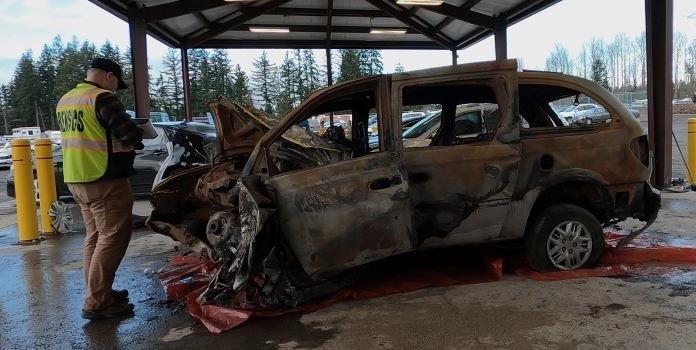3D Scanning-Based Accident Reconstruction
3D Scanning for Accident Reconstruction
Accident reconstruction involves determining the events leading to, during, and after a traffic collision. At Digital Scan 3D LLC, we have a team of 3D scanning accident reconstruction professionals that can create precise and detailed models of accident scenes. These models provide invaluable data for analysis, helping to understand the dynamics of the collision and providing evidence for legal and insurance purposes.
Key Features and Benefits of 3D Scanning in Accident Reconstruction
1. High Precision and Accuracy: 3D scanners capture detailed measurements of the accident scene, vehicles, and any relevant objects with high precision. This accuracy ensures that all critical details are documented, which is essential for thorough analysis. The Artec Ray Long Range 3D Scanner and Artec Leo Wireless 3D Scanner both provide the best solution to capture data fast and efficiently with texture/color.
2. Comprehensive Documentation: Provides a complete and permanent digital record of the accident scene, including topography, road conditions, and vehicle positions. Ensures no detail is overlooked, allowing for comprehensive post-accident analysis.
3. Time Efficiency: Rapid data collection reduces the time required to document accident scenes, minimizing road closure times and traffic disruptions. Faster scene processing allows investigators to clear scenes more quickly, improving overall efficiency.
4. Enhanced Visualization: Generates 3D models and animations that offer a clear and realistic visualization of the accident, aiding in understanding and presentation.
Enables investigators, legal professionals, and juries to visualize the accident dynamics accurately.
5. Improved Analysis: Facilitates detailed analysis of the accident, including speed, impact angles, deformation, and trajectories. Supports advanced simulations to reconstruct the accident sequence and understand causality.
6. Objective Evidence: Provides objective and unbiased evidence that can be used in court or insurance claims. Digital data is difficult to tamper with, enhancing the reliability of the evidence.
Applications of 3D Scanning in Accident Reconstruction
1. Traffic Collisions: Analyzing car, truck, and motorcycle accidents to determine fault and reconstruct the events leading to the collision.
2. Pedestrian and Bicycle Accidents: Documenting scenes involving pedestrians and cyclists to understand impact points and movement trajectories.
3. Industrial and Workplace Accidents: Reconstructing incidents in industrial settings to improve safety protocols and prevent future occurrences.
4. Public Safety and Law Enforcement: Assisting law enforcement agencies in documenting and analyzing crime scenes involving vehicular incidents.
Technology Used in 3D Scanning for Accident Reconstruction
1. LiDAR Scanners: Utilizes light detection and ranging technology to create high-resolution 3D models of accident scenes. Effective for capturing large areas and complex environments.
2. Photogrammetry: Uses photographs taken from multiple angles to generate 3D models. Suitable for smaller scenes and detailed object reconstruction.
3. Total Stations: Combines laser distance measurement with electronic angle measurement to create accurate 3D point clouds. Often used for forensic mapping in accident reconstruction.
4. Drones: Equipped with cameras and LiDAR sensors to capture aerial views of accident scenes. Provides additional perspectives and access to difficult-to-reach areas.

Process of 3D Scanning-Based Accident Reconstruction
1. Scene Documentation: Deploy 3D scanners and drones to capture the accident scene from multiple angles. Collect data on vehicle positions, road conditions, debris, and other relevant details.
2. Data Processing: Convert raw scan data into 3D models using specialized software. Clean and process the data to remove noise and enhance accuracy.
3. Analysis and Reconstruction: Use the 3D models to analyze the accident, including speed calculations, impact angles, and deformation analysis. Create simulations and animations to reconstruct the accident sequence.
4. Reporting and Presentation: Generate detailed reports and visualizations to present findings. Provide evidence for legal proceedings, insurance claims, and safety reviews.
Challenges and Considerations
1. Initial Costs: Investment in 3D scanning equipment and software can be significant. Training personnel to effectively use the technology is also required. We provide both options of either doing the 3D Scanning for you or selling you the equipment and provide full training + support.
2. Data Management: Large datasets generated by 3D scanners require efficient storage and processing solutions. Ensuring data integrity and security is crucial. We can share computer specifications we recommend.
3. Technical Expertise: Requires skilled professionals to operate the equipment and analyze the data. Continuous training and education are necessary to keep up with technological advancements.
3D scanning technology has revolutionized accident reconstruction by providing highly accurate and detailed digital models of accident scenes. This technology enhances the precision of analysis, improves visualization, and offers objective evidence for legal and insurance purposes. Despite the initial costs and technical requirements, the benefits of 3D scanning in accident reconstruction make it a valuable tool for professionals in the field, leading to more effective investigations and better-informed decisions.
